Go to Part 1
Go to Swingle Gallery
Go to Swingle Discography
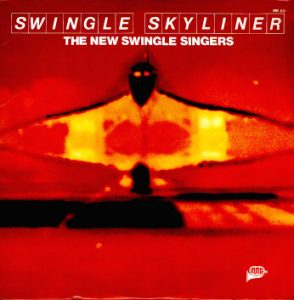 When the group, now known as the New Swingle Singers, moved to EMI in the late 70s, they recorded a new Christmas LP, and two more contrasting albums. “Swingle Skyliner” was a big band tribute. In a way, this was Swingle’s version of the classic Lambert, Hendricks and Ross album “Sing a Song of Basie”, in that the voices were overdubbed to recreate all of the instrumental parts, and that many of the new lyrics were penned by Jon Hendricks. However, rather than focusing on the Basie band, “Skyliner” was a cross-section of many different big bands from Duke Ellington’s 1930 “Mood Indigo” to Thad Jones and Mel Lewis’ 1970 “Us”. There were also recreations of classic big band vocal groups such as the Pied Pipers on “Sunny Side of the Street” and the Modernaires on “Chattanooga Choo Choo”. While some of the solo work veers toward the smoky chanteuse stereotypes of jazz singing, the ensemble work is very impressive. “Folio” was another wordless album of classical adaptations which added favorites like Debussy’s “Clair de Lune” and Rimsky-Korsakoff’s “Flight of the Bumblebee” to the Swingle repertoire. Several of the pieces were set to rock and disco beats, and a few arrangements called for double- and triple-tracked voice parts. Many of the pieces on both “Skyliner” and “Folio” were later re-scored for concert performances by the group.
When the group, now known as the New Swingle Singers, moved to EMI in the late 70s, they recorded a new Christmas LP, and two more contrasting albums. “Swingle Skyliner” was a big band tribute. In a way, this was Swingle’s version of the classic Lambert, Hendricks and Ross album “Sing a Song of Basie”, in that the voices were overdubbed to recreate all of the instrumental parts, and that many of the new lyrics were penned by Jon Hendricks. However, rather than focusing on the Basie band, “Skyliner” was a cross-section of many different big bands from Duke Ellington’s 1930 “Mood Indigo” to Thad Jones and Mel Lewis’ 1970 “Us”. There were also recreations of classic big band vocal groups such as the Pied Pipers on “Sunny Side of the Street” and the Modernaires on “Chattanooga Choo Choo”. While some of the solo work veers toward the smoky chanteuse stereotypes of jazz singing, the ensemble work is very impressive. “Folio” was another wordless album of classical adaptations which added favorites like Debussy’s “Clair de Lune” and Rimsky-Korsakoff’s “Flight of the Bumblebee” to the Swingle repertoire. Several of the pieces were set to rock and disco beats, and a few arrangements called for double- and triple-tracked voice parts. Many of the pieces on both “Skyliner” and “Folio” were later re-scored for concert performances by the group.
The Swingle Singers appeared on a 1982 televised concert from St. Paul’s Cathedral in London where they performed the sacred music of Duke Ellington with Tony Bennett, Phyllis Hyman, McHenry Boatwright and an all-star British big band. Shortly thereafter, they recorded an outstanding live album at the 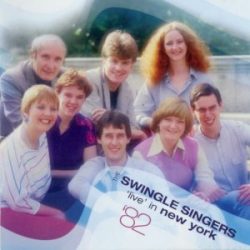 Village Gate in New York. Recorded direct to two-track over two nights, “Live in New York” offers a superb cross-section of the group’s repertoire. It is the first recording of the group performing its classical adaptations in an a cappella setting. The group–Olive Simpson and Kym Amps on soprano, Sue Bickley and Carol Canning on altos, Philip Sheffield and Swingle on tenor, and Michael Dore and Simon Grant on bass–was, in Swingle’s opinion, was one of the strongest editions of the group to date. Grant could sing uncanny imitations of bass and drums, and Swingle found that the group could perform all their concerts without instrumentalists (Swingle’s occasional spots of jazz piano are the only accompaniment on the “Live in New York” album). Most importantly, the recording—on which no individual voice could be redubbed—shows the absolute perfection of the Swingle Singers as a vocal ensemble. There are simply no mistakes to be heard, and a remarkable group sound to be cherished. The audio clips below feature two selections from the recording. Ward Swingle’s breezy setting of “Come Live with Me” displays stunning ensemble work and rhythmic vitality, while Henry VIII’s “Pastime With Good Company” offers the group’s uncanny imitations of Renaissance instruments, including tabors, crumhorns and recorder.
Village Gate in New York. Recorded direct to two-track over two nights, “Live in New York” offers a superb cross-section of the group’s repertoire. It is the first recording of the group performing its classical adaptations in an a cappella setting. The group–Olive Simpson and Kym Amps on soprano, Sue Bickley and Carol Canning on altos, Philip Sheffield and Swingle on tenor, and Michael Dore and Simon Grant on bass–was, in Swingle’s opinion, was one of the strongest editions of the group to date. Grant could sing uncanny imitations of bass and drums, and Swingle found that the group could perform all their concerts without instrumentalists (Swingle’s occasional spots of jazz piano are the only accompaniment on the “Live in New York” album). Most importantly, the recording—on which no individual voice could be redubbed—shows the absolute perfection of the Swingle Singers as a vocal ensemble. There are simply no mistakes to be heard, and a remarkable group sound to be cherished. The audio clips below feature two selections from the recording. Ward Swingle’s breezy setting of “Come Live with Me” displays stunning ensemble work and rhythmic vitality, while Henry VIII’s “Pastime With Good Company” offers the group’s uncanny imitations of Renaissance instruments, including tabors, crumhorns and recorder.
Pastime with Good Company
Come Live with Me
In 1984, following a new recording of the Berio “Sinfonia” with Pierre Boulez, Ward Swingle retired from touring and singing, and began a permanent tenure as the Swingle Singers’ musical advisor (Swingle also worked as a choral 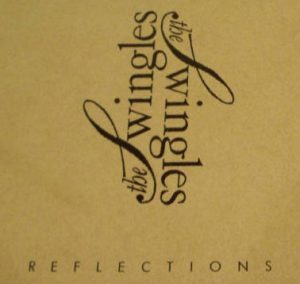 clinician. For an excellent example of Swingle’s coaching methods, see the video “Swingle Singing”). For the new edition of the Swingle Singers, Olive Simpson and Simon Grant shared responsibilities as musical directors. The first album recorded after Swingle’s departure, “Reflections”, acts as a natural extension of the group’s legacy. Most of the arrangements are by Swingle, and all of the pieces are sung a cappella. A few charts add vocal percussion, but most have ample rhythmic propulsion embedded in the individual parts. Gene Puerling’s setting of “London by Night” was borrowed from the library of the Singers Unlimited, Carol Canning contributed an arrangement of Monk’s “Round Midnight” and Swingle’s replacement as second tenor, Jonathan Rathbone, wrote a graceful setting of Bach’s “Bist Du Bei Mir”. But the best arrangement on the album is Swingle’s version of “All the Things You Are”. In just over three minutes, Swingle offers a kaleidoscopic setting that embraces in turn, lush romanticism, Swingle-style scat and big band shout choruses. Then, in a brilliant coda, he ties the whole piece together with elements of each style.
clinician. For an excellent example of Swingle’s coaching methods, see the video “Swingle Singing”). For the new edition of the Swingle Singers, Olive Simpson and Simon Grant shared responsibilities as musical directors. The first album recorded after Swingle’s departure, “Reflections”, acts as a natural extension of the group’s legacy. Most of the arrangements are by Swingle, and all of the pieces are sung a cappella. A few charts add vocal percussion, but most have ample rhythmic propulsion embedded in the individual parts. Gene Puerling’s setting of “London by Night” was borrowed from the library of the Singers Unlimited, Carol Canning contributed an arrangement of Monk’s “Round Midnight” and Swingle’s replacement as second tenor, Jonathan Rathbone, wrote a graceful setting of Bach’s “Bist Du Bei Mir”. But the best arrangement on the album is Swingle’s version of “All the Things You Are”. In just over three minutes, Swingle offers a kaleidoscopic setting that embraces in turn, lush romanticism, Swingle-style scat and big band shout choruses. Then, in a brilliant coda, he ties the whole piece together with elements of each style.
Shortly after his retirement, Ward Swingle contributed to a jazz version of Bach’s “Magnificat” which featured the Swingle Singers, Bobby McFerrin, Ann Mortifee and Moe Koffman. The piece was created for a 1985 Toronto concert that featured both the traditional and jazz versions of Bach’s choral masterwork. The music was never commercially recorded, but the rehearsals and performance were filmed by Barbara Willis Sweete for a unique documentary that cut between the two contrasting versions of the work. The instrumental adaptation was created by keyboardist Eric Robertson, and while much of the arrangement hews to Bach’s original, there are a few surprising segments that take the music in a completely different direction, including the quite non-Bachian gong near the end of “Quia Fecit Mihi Magna” and the gospel-styled concluding movement. Swingle reset Bach’s original choral parts, using scat syllables in place of the original melismas. In an interview for the film, Swingle related that it was difficult for the Swingle Singers to switch between the scat syllables and the Latin text, partially because all of the singers had sung the traditional version and had trouble shaking off the stigma of the original work. McFerrin and Mortifee also stated that they had to work hard at loosening their approach to the music. Overall, the piece works well both on its own terms and as an interesting alternative to the original.
By 1987, both Simpson and Grant had left the group. The next album by the Swingle Singers was a live recording made at Ronnie Scott’s nightclub in London. The album was co-produced by Jon Miller (who had also produced “Reflections”) along with Canning and Rathbone. The album is a near disaster. Most of the music—a mixture of synthesizer-rich pop tunes and big band swing covers—sounds nothing like the Swingle Singers (the backup band even includes a horn section!) The only saving moments of this recording are the Ward Swingle arrangements of “Li’l Darlin’” (which had appeared on both “Swingle Skyliner” and “Live in ‘82”) and “Boplicity” which dated back to the days of Les Doubles Six. “Reflections” and “Live at Ronnie Scott’s” were issued on CD as “Compilation Album” on the Swingles’ own label, and have been out of print for many years.
When Jonathan Rathbone took over the musical directorship of the group, he made several changes. The group went back to the a cappella style with vocal imitations of bass and drums, and there were several new arrangements penned by Rathbone and fellow members Ben Parry and (later) Mark Williams. Most importantly, Rathbone increased the group’s visibility with a flood of new recordings for the Swingles’ own label (some of these were later re-packaged 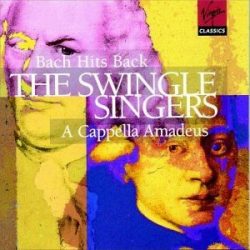 and reissued by Virgin Classics). This edition of the group was particularly fine, and with the exception of a couple of changes to the first soprano chair, it stayed together for about five years. Helen Massey (later to become Mrs. Rathbone) sang first soprano from 1986-1989, followed by Nikki Sharkey (1989-1990) and Jenny Fowler (1990-1993). Deryn Edwards sang second soprano from 1987-1992 and then returned to the group from 1996-1998. Linda Stevens and Heather Cairncross held the alto spots, with Andrew Busher and Rathbone as tenors and Parry and David Porter-Thomas singing bass. The imitations of bass and drums were so realistic that the CD included a note that all of the sounds were created by the human voice (many years earlier, the Mills Brothers included a similar legend on the labels of their records). There were several excellent albums recorded during Rathbone’s tenure. Both Bach and Mozart were revisited, with each disc providing a mix of vocal and instrumental works. The original lyrics were sung where applicable, with scat used everywhere else. Most of the arrangements are from Rathbone or Parry (or both in collaboration), but comparing them to the handful of arrangements by Swingle on the discs, there is hardly a break in the tradition. The group is seen below in a performance of Parry’s arrangement of Mozart’s Overture to “The Magic Flute”.
and reissued by Virgin Classics). This edition of the group was particularly fine, and with the exception of a couple of changes to the first soprano chair, it stayed together for about five years. Helen Massey (later to become Mrs. Rathbone) sang first soprano from 1986-1989, followed by Nikki Sharkey (1989-1990) and Jenny Fowler (1990-1993). Deryn Edwards sang second soprano from 1987-1992 and then returned to the group from 1996-1998. Linda Stevens and Heather Cairncross held the alto spots, with Andrew Busher and Rathbone as tenors and Parry and David Porter-Thomas singing bass. The imitations of bass and drums were so realistic that the CD included a note that all of the sounds were created by the human voice (many years earlier, the Mills Brothers included a similar legend on the labels of their records). There were several excellent albums recorded during Rathbone’s tenure. Both Bach and Mozart were revisited, with each disc providing a mix of vocal and instrumental works. The original lyrics were sung where applicable, with scat used everywhere else. Most of the arrangements are from Rathbone or Parry (or both in collaboration), but comparing them to the handful of arrangements by Swingle on the discs, there is hardly a break in the tradition. The group is seen below in a performance of Parry’s arrangement of Mozart’s Overture to “The Magic Flute”.
Rathbone seemed particularly interested in expanding the group’s repertoire. “Pretty Ring Time” is a beautifully sung album featuring arrangements of 20th century British art songs. Although the pieces were originally written for solo voice and piano, the settings by Rathbone and Williams make them sound completely natural in a choral setting. For the remarkable blend of the voices and pure vocal tone production, this album sits alongside the Swingle II RCA album as one of the finest in the Swingle Singers discography. “Around the World” was the first Swingles album dedicated to folk songs. Many of the arrangements are very rhythmic and over the course of the hour-long program, the group sings in seven different languages, plus their trademark scat. They are seen here singing the Scottish folk song, “Charlie Is My Darling”, in a performance that draws from the best traditions of choral music.
A number of extra-musical elements led to Rathbone’s departure and the near dissolution of the Swingle Singers. The tenures of the following two musical 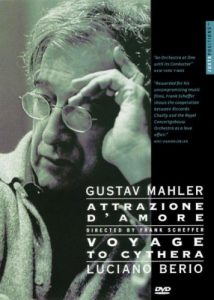 directors, Mark Williams and Rachel Weston were marked by constantly shifting personnel and severely reduced recording activity . Both Williams and Weston had been part of the Swingle Singers during Rathbone’s tenure, and they instilled their deep knowledge of the Swingle style to the new members. The group recorded one album under Williams’ leadership, “Screen Tested”, a collection of movie themes ranging from William Walton’s “Touch Her Soft Lips and Part” (from “Henry V”) to the theme from “Mission Impossible”. While five of the arrangements on that album were written by either Rathbone or Parry, Williams wrote five new arrangements, and Weston contributed two. Around the same time, the group appeared in the film, “Voyage to Cythera” which documented rehearsals and performances of the Berio “Sinfonia”. The film focused on the Scherzo and traced several of the musical quotes embedded in the score. Berio was interviewed for the film, and is seen conducting the work with the Swingles and the Royal Concertgebouw Orchestra. Williams read the Beckett monologue, and in a brief sequence, he can be seen rehearsing the vocalists.
directors, Mark Williams and Rachel Weston were marked by constantly shifting personnel and severely reduced recording activity . Both Williams and Weston had been part of the Swingle Singers during Rathbone’s tenure, and they instilled their deep knowledge of the Swingle style to the new members. The group recorded one album under Williams’ leadership, “Screen Tested”, a collection of movie themes ranging from William Walton’s “Touch Her Soft Lips and Part” (from “Henry V”) to the theme from “Mission Impossible”. While five of the arrangements on that album were written by either Rathbone or Parry, Williams wrote five new arrangements, and Weston contributed two. Around the same time, the group appeared in the film, “Voyage to Cythera” which documented rehearsals and performances of the Berio “Sinfonia”. The film focused on the Scherzo and traced several of the musical quotes embedded in the score. Berio was interviewed for the film, and is seen conducting the work with the Swingles and the Royal Concertgebouw Orchestra. Williams read the Beckett monologue, and in a brief sequence, he can be seen rehearsing the vocalists.
By all accounts, Williams’ departure from the group was rather sudden and unexpected. Weston became musical director and she juggled the rigors of a busy international touring schedule with constant changes in personnel and the necessary auditions to find replacements. She came into the position with three new singers to train, including future musical director Joanna Forbes. For several months, the group had no regular baritone and Weston brought in former members including Michael Dore, Jonathan Rathbone and Ben Parry to fill in for concert tours. Eventually, Forbes’ father recommended one of his 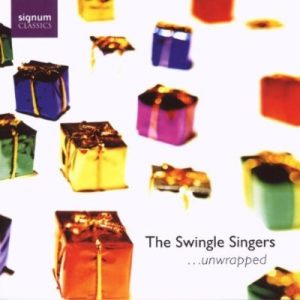 former students, Jeremy “Jes” Sadler, who became a long-standing member of the group. Later in 1998, two more singers from the Rathbone era, Heather Cairncross and David Porter-Thomas, left the group. After working with their replacements for a few months, Weston decided to move on as well.
former students, Jeremy “Jes” Sadler, who became a long-standing member of the group. Later in 1998, two more singers from the Rathbone era, Heather Cairncross and David Porter-Thomas, left the group. After working with their replacements for a few months, Weston decided to move on as well.
When Joanna Forbes became the new musical director, none of the members had been with the group for more than a year. None had recorded as part of the Swingle Singers. With the help of the Swingles’ veteran engineer John Milner, the group resumed recording with “Ticket to Ride”. This Beatles tribute album had been discussed during Weston’s tenure, and the track list included several Rathbone and Parry arrangements along with new settings by Forbes’ husband, Alexander L’Estrange. The Swingle Singers made six albums under Forbes’ leadership. While there were several personnel changes during this period, the group eventually found its own voice and in the process found its own way to incorporate pop music into its repertoire. On later albums like “Live in Japan” and “Unwrapped”, the arrangements brought a new sensibility and intelligence to the music. “Live in Japan” contains a fascinating makeover of Queen’s “Bohemian Rhapsody” (audio below), and the versions of “River”, “Walking in the Air” and “Last Christmas” on “Unwrapped” are thoughtful and moving settings of these contemporary pop standards.
Bohemian Rhapsody
Forbes had been a fan of the Swingle Singers since childhood, and she was keenly aware of the group’s heritage. In her first year as musical director, she continued the Swingles legacy of performing contemporary music, including a collaboration with composer Michael Nyman, concerts with Momix, a 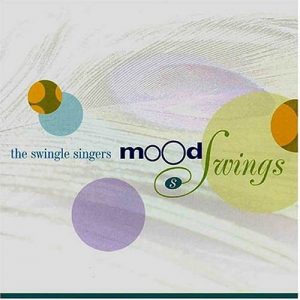 contemporary dance troupe from New York, and performances of Berio’s final opera “Outis”. She also strengthened the group’s relationship with Ward Swingle, and she included his arrangements on several of the group’s albums. “Keyboard Classics” was an a cappella collection of music from Bach to Satie, with half of the arrangements coming from Swingle’s pen. “Live in Japan” included three new Swingle arrangements of Kurt Weill songs, and on “Retrospective: The 40th Anniversary Tour”, Forbes brought out a dozen original Swingle arrangements from the 60s and 70s, and the group performed them live with bass and drum accompaniment.“Mood Swings” showed that the group was well-versed in several different genres. On the album’s opener, “So What”, the lead of Wendy Nieper (whose scat solo is loosely based on Miles Davis’ trumpet solo) and the vocal rhythm section of Sadler and Hug inspire one of the Swingles’ finest efforts in straight-ahead swing (audio below). The album is split into several segments, including ballads, standards and “1960s Latin jazz”, the latter encompassing both Brazilian samba and Argentinean tango. The standards section includes a new recording of Ward Swingle’s “All the Things You Are”, and a sub-section of Richard Rodgers songs includes Rathbone’s complex setting of “My Funny Valentine”. The samba groove on Antonio Carlos Jobim’s “Surfboard” is superbly conceived and expertly realized. The album concludes with Alexander L’Estrange’s delightful arrangement of Quincy Jones’ “Soul Bossa Nova”, a piece well-known from its appearance in the Austin Powers movies, and one that would play an integral role in a later Swingles project.
contemporary dance troupe from New York, and performances of Berio’s final opera “Outis”. She also strengthened the group’s relationship with Ward Swingle, and she included his arrangements on several of the group’s albums. “Keyboard Classics” was an a cappella collection of music from Bach to Satie, with half of the arrangements coming from Swingle’s pen. “Live in Japan” included three new Swingle arrangements of Kurt Weill songs, and on “Retrospective: The 40th Anniversary Tour”, Forbes brought out a dozen original Swingle arrangements from the 60s and 70s, and the group performed them live with bass and drum accompaniment.“Mood Swings” showed that the group was well-versed in several different genres. On the album’s opener, “So What”, the lead of Wendy Nieper (whose scat solo is loosely based on Miles Davis’ trumpet solo) and the vocal rhythm section of Sadler and Hug inspire one of the Swingles’ finest efforts in straight-ahead swing (audio below). The album is split into several segments, including ballads, standards and “1960s Latin jazz”, the latter encompassing both Brazilian samba and Argentinean tango. The standards section includes a new recording of Ward Swingle’s “All the Things You Are”, and a sub-section of Richard Rodgers songs includes Rathbone’s complex setting of “My Funny Valentine”. The samba groove on Antonio Carlos Jobim’s “Surfboard” is superbly conceived and expertly realized. The album concludes with Alexander L’Estrange’s delightful arrangement of Quincy Jones’ “Soul Bossa Nova”, a piece well-known from its appearance in the Austin Powers movies, and one that would play an integral role in a later Swingles project.
So What
When Forbes left the Swingle Singers in 2004, Tom Bullard took over as musical director for a brief period, and Tobias Hug became artistic director.  Since joining the Swingles in 2001, Hug had wanted to diversify the group’s repertoire and embrace the sounds of contemporary a cappella music. On the 2007 album, “Beauty and the Beatbox”, the Swingle Singers collaborated with vocal percussionist Shlomo and five British beatboxers, known collectively as “the Vocal Orchestra”. The result was an album which amplified the Swingles’ already powerful rhythmic style, and brought the group to the forefront of the a cappella music scene. While some of the tune choices are questionable (did we really need a new version of “A Fifth of Beethoven” or the “Badinerie” set to a hip-hop beat?), the album includes beautifully realized arrangements of Ravel’s “Bolero”, Chick Corea’s “Spain” and the Mexican folk song “Cielto Lindo”.
Since joining the Swingles in 2001, Hug had wanted to diversify the group’s repertoire and embrace the sounds of contemporary a cappella music. On the 2007 album, “Beauty and the Beatbox”, the Swingle Singers collaborated with vocal percussionist Shlomo and five British beatboxers, known collectively as “the Vocal Orchestra”. The result was an album which amplified the Swingles’ already powerful rhythmic style, and brought the group to the forefront of the a cappella music scene. While some of the tune choices are questionable (did we really need a new version of “A Fifth of Beethoven” or the “Badinerie” set to a hip-hop beat?), the album includes beautifully realized arrangements of Ravel’s “Bolero”, Chick Corea’s “Spain” and the Mexican folk song “Cielto Lindo”.
Joanna Goldsmith-Eteson became musical director in 2009 and is still part of the Swingle Singers’ “music team”. The current group has added immeasurably to its audiences and fame through expert use of social media. All of the current members have active Facebook and Twitter accounts, there is an excellent website with tour information, biographies and a blog, and several superb concert performances have appeared on YouTube. However, the Swingles have not been content to rely on video postings from their fans. On May 21, 2010, they staged and filmed a “flash mob” performance on a London Underground train. The YouTube video—which went viral within days—is shown below, and one can see all of the members of the group. Bass Tobias Hug is dressed as a construction worker, complete with iPod and coffee cup, alto Lucy Bailey is the blond sitting next to him, soprano Sara Brimer (with the pixie haircut) and alto Clare Wheeler, also with an iPod, are standing holding the red poles, bass Kevin Fox is in the blue shirt behind Wheeler, tenor Christopher Jay (known as “CJ”) sits on the right bench wearing a hat, Joanna Goldsmith-Eteson sits one spot away from him, and her husband Richard “Willy” Eteson is standing by Fox and Wheeler, getting a great close-up as the group launches into “Soul Bossa Nova” (The interpolation of “In the Air Tonight” was not part of L’Estrange’s original arrangement, but was added as an homage to the group, Naturally 7, who performed that song in a flash mob on a Paris Métro train a few years earlier). While the appeal of the Swingles’ performance is obvious, I find the rhythmic energy quite exemplary (especially since the trains on “the tube” have a rhythm all their own!) The video was created to advertise a Swingle Singers concert, and due to its popularity, the Swingles were invited to lead the impromptu singing for a T-Mobile commercial filmed at Heathrow Airport’s international terminal.
The television show, “Glee” has raised worldwide enthusiasm for a cappella music, especially among high school and college singers. The Swingle Singers appeared several times on the soundtrack of the pilot episode and they now offer a “Glee” clinic, where school choral groups get to work directly with the Swingles on style, movement and performance practice. A larger part of the Swingles’ educational outreach is the London A Cappella Festival, which just completed its third year. The festival brings together all kinds of unaccompanied groups, from barbershop to beatbox, with groups and fans assembling in London from around the world. The festival includes workshops, forums, coaching sessions and numerous performances, both on stage at King’s Place and in the theatre lobby. Naturally, the Swingle Singers are one of the featured groups, and at this year’s festival, they performed on two of the three evening concerts.
 Tobias Hug has called the 2007-2008 CD “Ferris Wheels”, “the most democratic album” in the Swingles’ discography. Six of the members contributed arrangements and nearly all performed as soloists, bringing a deep feeling of community involvement to the recording. The music covers a wide range of pop music, including Bjork, James Taylor, Joni Mitchell, Nick Drake, Sting and Michel Legrand, the arrangements are well-crafted, and the performances are dynamic with tight vocal percussion and brilliantly sung harmonies. The arrangements have been adapted for orchestral performance, and were recently presented in a concert featuring the Swingles and the Boston Pops.
Tobias Hug has called the 2007-2008 CD “Ferris Wheels”, “the most democratic album” in the Swingles’ discography. Six of the members contributed arrangements and nearly all performed as soloists, bringing a deep feeling of community involvement to the recording. The music covers a wide range of pop music, including Bjork, James Taylor, Joni Mitchell, Nick Drake, Sting and Michel Legrand, the arrangements are well-crafted, and the performances are dynamic with tight vocal percussion and brilliantly sung harmonies. The arrangements have been adapted for orchestral performance, and were recently presented in a concert featuring the Swingles and the Boston Pops.
The Swingle Singers have attracted non-British singers for many years, and the current group has three members from outside the UK. Sara Brimer hails from Tennessee, Kevin Fox is Canadian, and Tobias Hug comes from Germany. While Brimer had a strong background in music education and the British choral tradition, Fox believes that the group has a deeper and richer blend because of the geographical diversity of the voices. He also says that “having an audible differentiation from singer to singer allows individual personalities to come through”. The group has maintained a fairly stable personnel which has helped to further strengthen an already rich ensemble sound. In the autumn of 2010, Oliver Griffiths replaced Richard Eteson as first tenor, and Griffith’s wide range has played an important role in the group’s 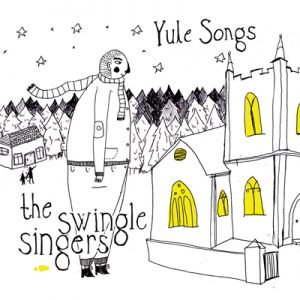 evolution. Like all of the Swingle Singers that came before him, Griffiths went through an extensive audition process which involved learning about 16 pieces from the repertoire. Once he was accepted into the group, he had to memorize another 20 songs (complete with choreography) and prepare for a performance of the Berio “Sinfonia”! One of Griffith’s earliest performances with the group was on the Swingle’s first music video, Kineret Erez‘ brilliant unaccompanied arrangement of Astor Piazzolla’s “Libertango” (below). Since the release of that video, the Swingle Singers have also collaborated with the American a cappella pop singer Peter Hollens on a version of “Poor Wayfaring Stranger” and sang for an animated video version of “O Come, O Come Emmanuel” from their latest EP, “Yule Songs”.
evolution. Like all of the Swingle Singers that came before him, Griffiths went through an extensive audition process which involved learning about 16 pieces from the repertoire. Once he was accepted into the group, he had to memorize another 20 songs (complete with choreography) and prepare for a performance of the Berio “Sinfonia”! One of Griffith’s earliest performances with the group was on the Swingle’s first music video, Kineret Erez‘ brilliant unaccompanied arrangement of Astor Piazzolla’s “Libertango” (below). Since the release of that video, the Swingle Singers have also collaborated with the American a cappella pop singer Peter Hollens on a version of “Poor Wayfaring Stranger” and sang for an animated video version of “O Come, O Come Emmanuel” from their latest EP, “Yule Songs”.
When Lucy Bailey left the Swingle Singers in mid-2011, the group shocked the a cappella world with the news that they would not replace her, but reduce the group to seven voices. While there may have been some economic reasons for making the change, alto and arranger Clare Wheeler asserts the artistic advantages of the reduced group: “With both basses involved in providing the rhythm section, we had the chance for a better balance in the harmony parts: two male voices, and now three female voices rather than four. This works particularly well in the current line-up.” CJ is, like Ward Swingle, a high baritone rather than a low tenor (the difference is in vocal timbre, rather than range), Griffith’s range extends into the alto register where Wheeler’s low voice meets his, and the sopranos have great flexibility, with each able to soar high above the group. The “music team” of Goldsmith-Eteson, Wheeler and Fox re-wrote the arrangements, re-voicing chords that didn’t work, and re-distributing the solos where appropriate. Ward Swingle said that he had the opportunity to examine the new arrangements and felt that “they worked very well”. The new vocal setup allowed the members to create new music for the group, and on the aforementioned EP, “Yule Songs”, there are original works by Brimer, Goldsmith-Eteson and Wheeler.
As the Swingle Singers prepare for their 50th anniversary celebration, they have an additional challenge to face: after 11 years, Tobias Hug has announced that he is leaving the group. As noted above, Hug has been an integral part of the Swingles’ growth in the past decade, and no doubt, he will be difficult to replace. In a BBC Radio 3 interview promoting the 2012 London A Cappella Festival, interviewer Sean Rafferty asked how long one could remain as a Swingle Singer. Fox answered that members could stay as long as they wanted, and then Hug remarked that “the touring takes a toll”. It was easy to discern the fatigue in Hug’s voice, and later that night, the announcement of his departure was posted on Facebook. Of course, the Swingle Singers will move forward as they always have, and the new bass will doubtlessly bring an entire new set of musical experiences with him. And once again, the Swingle Singers will evolve, while continuing to make the music dance.
Go to Swingle Discography Part 1
Go to Swingle Discography Part 2
This article is dedicated to the memory of Christiane Legrand and André Hodier who both passed away on November 1, 2011, as this article was being researched. It is my deep regret that their voices (as well as the late Mimi Perrin) were not active parts of this history.
My deepest thanks go to Ward Swingle. His superb book “Swingle Singing” packs an enormous amount of information in less than 100 pages, and in lengthy phone conversations with me, he amplified several important details about the history of the Swingle Singers. I am also indebted to Ward’s wife, Françoise, and his daughters Rebecca and Elizabeth for their assistance and input.
Thanks to Joanna Forbes L’Estrange and Rachel Weston for providing vital information on their years as performers and musical directors for the Swingle Singers.
The current Swingle Singers were very helpful as I wrote the final portion of this article. Many thanks to them: Joanna Goldsmith-Eteson, Sara Brimer, Clare Wheeler, Oliver Griffiths, Christopher Jay, Kevin Fox and Tobias Hug. Additional thanks to the Swingles’ management team at Ikon Arts: Costa Peristianis, Jessica Hill and Natalia Franklin Pierce.
Audio and video recordings provided by Ward Swingle, Bullfrog Films, Ikon Arts, Michael Lawrence, John Neal and Primarily A Cappella, Terry Lewis and California State University-Fresno’s Music Library, and the University of Northern Colorado Music Library. Special thanks to Lisa Wood of Denver Public Library’s Interlibrary Loan department.
The audio and video recordings embedded in this article are presented for educational and illustrative purposes. Jazz History Online neither owns nor controls the rights to these recordings. All rights belong to the original copyright holders.
Go to Swingle Gallery
Go to Swingle Discography